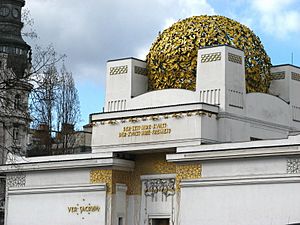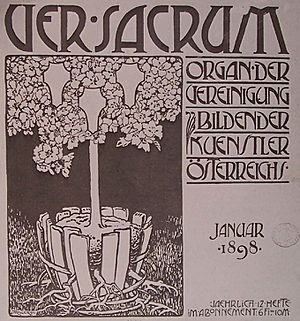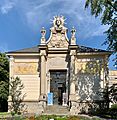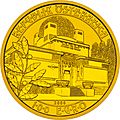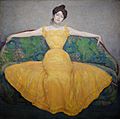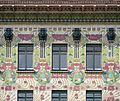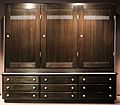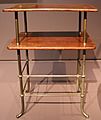Vienna Secession facts for kids
The Vienna Secession was a special group of artists in Austria. They formed in 1897 because they wanted to create new kinds of art. They felt the older art groups were too traditional. This group included painters, sculptors, and architects.
The Secession was started on April 3, 1897. Key artists like Gustav Klimt, Koloman Moser, Josef Hoffmann, Joseph Maria Olbrich, and Max Kurzweil were among the founders. Even though he was very important, the architect Otto Wagner joined later.
The group held its first art show in 1898. That same year, they built their own exhibition hall. It was near Karlsplatz in Vienna. Joseph Maria Olbrich designed this building. People soon called it "the Secession" building. The artists also shared their ideas in a magazine named Ver Sacrum.
In 1903, Josef Hoffmann and Koloman Moser started another group. It was called the Wiener Werkstätten. This group focused on making beautiful everyday objects. They wanted to change how applied arts (like crafts and design) were seen. Later, in 1905, Gustav Klimt and some other artists left the Secession. They had different ideas about art.
Contents
Who Were the Vienna Secession Artists?
The Vienna Secession had many talented members. They explored new styles in painting, sculpture, and architecture. Here are some of the artists who were part of this exciting movement:
- Gustav Klimt
- Koloman Moser
- Josef Hoffmann
- Joseph Maria Olbrich
- Max Kurzweil
- Otto Wagner
- Carl Moll
- Egon Schiele
- Oskar Kokoschka
- Richard Gerstl
- Julius Exter
- Max Fabiani
- Jože Plečnik
- Malva Schalek
- Othmar Schimkowitz
What Was the Secession Building Like?
The Secession building is a famous landmark in Vienna. It was designed by Joseph Maria Olbrich. The building has a unique look. It features a large golden dome made of leaves. This dome is often called the "golden cabbage." The building's style was very modern for its time. It showed the new ideas of the Secession artists.
The building's entrance has a special motto. It says: "To every age its art, to every art its freedom." This motto explains what the Secession artists believed. They wanted to be free to create art in new ways.
What Was the Wiener Werkstätten?
The Wiener Werkstätten was a group started by Josef Hoffmann and Koloman Moser. They wanted to bring art into everyday life. They designed furniture, jewelry, textiles, and other objects. Their goal was to make beautiful, well-crafted items. They believed that art should not just be in museums. It should be part of people's homes and daily lives.
The Wiener Werkstätten had a big impact on design. They used simple shapes and high-quality materials. Their work helped shape modern design.
What Kind of Art Did They Make?
The Vienna Secession artists created many different types of art. They moved away from traditional styles. They used new colors, shapes, and ideas.
- Paintings: Artists like Gustav Klimt made famous paintings. His work often used gold and detailed patterns. The Kiss is one of his most well-known paintings.
- Architecture: Architects like Otto Wagner and Josef Hoffmann designed modern buildings. They used new materials and simpler forms.
- Decorative Arts: Artists also designed posters, magazines, and everyday objects. They wanted art to be part of everything. The Ver Sacrum magazine showed their new artistic ideas.
Why Was the Secession Important?
The Vienna Secession was very important for art history. It helped change how people thought about art. The artists broke away from old rules. They explored new ways to express themselves. They influenced many future art movements. Their ideas helped lead to modern art and design. They showed that art could be new, exciting, and for everyone.
Images for kids
-
Palace of Art, also known as "Secession", of the Kraków Society of Friends of Fine Arts, in Krakow Old Town
-
Dance by Koloman Moser (1902), inspired by dancer Lois Fuller
-
Illustration to The Goose Girl by Maximilian Liebenwein, published in Ver Sacrum in 1902
-
The Kiss by Gustav Klimt (1907–08)
-
Secession Building by Joseph Maria Olbrich (1897-8)
-
Floral design by Alois Ludwig on the facade of one of the Linke Wienzeile Buildings by Otto Wagner (1898)
-
A medallion by Koloman Moser and sculptures by Othmar Schimkowitz at Linke Wienzeile 38 (1898)
-
Church of St. Leopold by Otto Wagner (1902-1907)
-
Austrian Postal Savings Bank by Otto Wagner (1904-1912)
-
Stoclet Palace by Josef Hoffmann in Brussels (1905-1911)
-
Cabinet by Joseph Maria Olbrich, of maple, fruitwood, ebony and brass (c. 1900) (Los Angeles Country Museum of Art)
-
Armchair by Joseph Maria Olbrich made for the Darmstadt Artists' Colony (1900)
-
Cabinet made for the offices of the newspaper Die Zeit, Otto Wagner, (1902)
-
Bookcase by Koloman Moser (1902) (Los Angeles Country Museum of Art)
-
Inlaid Armoire by Koloman Moser (1903) (Leopold Museum)
-
Adjustable-back chair Model 670 "Sitzmaschine" by Josef Hoffmann (1905)
-
The monument to Mark Antony by Arthur Strasser (1899)
-
Beethoven torso statue by Max Klinger for XIV Secession exhibition (1902)
See also
 In Spanish: Secesión de Viena para niños
In Spanish: Secesión de Viena para niños


